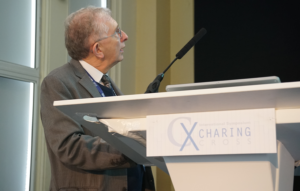
Michael Edmonds, a pioneer in the treatment of the diabetic foot, has underlined the need for innovation and development in the wound care field. Today, the emergence of multiple randomised controlled trials (RCTs) is driving the effort to upgrade treatments and provide better care to patients. In his article, Edmonds discusses a number of studies that are testing the efficacy of advanced wound dressings and therapies for diabetic foot patients, from LeucoPatch to topical wound oxygen.
1. Unhealed diabetic foot ulcers are a prelude to 84% of lower extremity amputations,¹ so it is important to heal ulcers quickly. However, the evidence base to promote the healing of diabetic foot ulcers has been deficient, leading to a call for well-designed clinical trials.² In response to this, there has been a renewed interest in diabetic foot care and several randomised controlled foot ulcer trials have been published.
2. In a randomised, double-blinded controlled study, a sucrose octasulphate dressing—which is a polyester mesh impregnated with a lipidocolloid matrix, containing sucrose octasulfate potassium salt—has been demonstrated as beneficial in non-infected, neuro-ischaemic diabetic foot ulcers that were difficult to heal, despite best standard of care.³ 126 participants were randomised to the sucrose octasulphate dressing and 114 to the control dressing, and after 20 weeks wound closure occurred in 60 patients (48%) from the sucrose octasulfate dressing group and 34 patients (30%) from the control dressing group (95% CI 5–30; adjusted odds ratio 2·60, 95% CI 1·43–4·73; p=0·002). Compared with the average healing time in the control group of 180 days, there was a significantly shorter healing time (reduced by 60 days) in participants treated with sucrose octasulphate dressing.
3. A multicentre randomised controlled trial assessed LeucoPatch in people with diabetes and hard-to-heal diabetic foot ulcers, including ischaemic feet down to an ABI index of 0.5. The weekly application of LeucoPatch, which provides autologous leucocytes, platelets, and fibrin, resulted in the healing of 45 (34%) out of 132 ulcers within 20 weeks, compared to 29 (22%) out of 134 ulcers in the standard care group without LeucoPatch treatment (odds ratio 1·58, 96% CI 1·04–2·40; p=0·0235) by intention-to-treat analysis. Time to healing was also shorter in the LeucoPatch group (p=0·0246) than in the standard care group.⁴
4. Diabetic patients with chronic lower extremity ulcers who received the weekly human amnion/chorion membrane dHACM allograft were significantly more likely to heal in 12 weeks compared with those not receiving dHACM (Intention To Treat-70% versus 50%, P = 0.0338, Per-Protocol-81% versus 55%, P = 0.0093), according to a prospective, randomised controlled multicentre clinical trial of 110 patients. A Kaplan-Meier analysis was performed to compare the time-to-healing performance with and without dHACM, showing a significantly improved time to healing with the use of allograft (P < 0.0187).⁵
5. The safety and efficacy of EDX110, a medical device that generates nitric oxide for the treatment of diabetic foot ulcers, was assessed in a multicentre randomised controlled trial.⁶ 135 participants with 148 ulcers—30% of which were clinically infected at baseline—were recruited (75 participants in the EDX110 group and -75 in the control group). Treatment lasted 12 weeks, or until healed, and saw both arms given optimal debridement, offloading and antimicrobial treatment. EDX110 achieved its primary endpoint by attaining a median percentage area reduction of 88.6% compared to 46.9% for the control group (p = 016) at 12 weeks.
6. Integra Dermal Regeneration Template was used to treat diabetic foot ulcers in a two-phase study consisting of 307 patients. The first phase of the study was a 14-day period which saw patients receive 0.9% sodium chloride gel, along with a secondary dressing and standard offloading. After the initial 14 days, the patients with less than 30% re-epithelialization entered into the second phase, which was randomized with a control group treated with 0.9% sodium chloride gel and a treatment group treated with Integra bilayer graft. After the 16-week follow-up, patients who received the Integra graft had a significantly greater complete closure rate (51%) versus the control group (32%) (p=0.001). The mean time to closure in the treatment group was 43 days versus 78 days for the control group, and weekly wound reduction size was 7.2% for the treatment group versus 4.8% for the control group (p=0.012).⁷
7. A randomised trial was undertaken to explore the efficacy of topical wound oxygen (TWO2) homecare therapy for diabetic foot ulcers that had failed to heal with standard of care alone.⁸ All subjects were enrolled into a standard of care run-in that included gold-standard offloading and sharp debridement. Only ulcers not on a proven healing trajectory with standard of care alone (<30% wound area reduction) were randomized into the active phase of the study, where they were assigned (double blind) to either active, or sham TWO2 device treatment arms. The primary endpoint of the study was ulcers healed at 12 weeks. At the first interim analysis point of 73 subjects, the active TWO2 arm was shown to be significantly superior to the sham arm (Pearson Chi2 =7.2707, P=0.007), increasing the likelihood of healing in 12 weeks by up to four times.
The goal should be to heal ulcers as quickly as possible and avoid the catastrophe of losing a leg to infection. These studies have described interventions that significantly improve healing, and it is hoped that this new dawn will usher in an age of enlightenment in the study of the basic and clinical science of diabetic foot ulcers, finally preventing major amputations which result from complications with unhealed foot ulcers.
Michael Edmonds is a professor of diabetic foot medicine, King’s College London, and consultant physician, King’s College Hospital, London, UK.
References:
- Pecoraro R, Reiber G, and Burgess E. Pathways to diabetic limb amputation: a basis for prevention. Diabetes Care 1990; 13: 513–521.
- Jeffcoate WJ, Bus SA, Game FL, et al. International Working Group on the Diabetic Foot and the European Wound Management Association. Reporting standards of studies and papers on the prevention and management of foot ulcers in diabetes: required details and markers of good quality. Lancet Diabetes Endocrinol 2016; 4: 781-788.
- Edmonds M, Lazaro-Martinez JL, Alfayate-Garcia JM, et al. Sucrose octasulfate dressing versus control dressing in patients with neuroischaemic diabetic foot ulcers (Explorer): an international, multicentre, double-blind, randomised, controlled trial. Lancet Diabetes Endocrinol 2018; 6: 186-96.
- Game F, Jeffcoate W, Tarnow L, Jacobsen JL, et al. LeucoPatch II trial team. LeucoPatch system for the management of hard-to-heal diabetic foot ulcers in the UK, Denmark, and Sweden: an observer-masked, randomised controlled trial. Lancet Diabetes Endocrinol. 2018 Nov; 6(11), 870–878. doi: 10.1016/S2213–8587(18)30240–7.
- Tettelbach W, Cazzell S, Reyzelman AM, et al. A confirmatory study on the efficacy of dehydrated human amnion/chorion membrane dHACM allograft in the management of diabetic foot ulcers: A prospective, multicentre, randomised, controlled study of 110 patients from 14 wound clinics. International Wound Journal 2018.
- Edmonds ME, Bodansky HJ, Boulton AJ, et al. Multicenter, randomized controlled, observer-blinded study of a nitric oxide generating treatment in foot ulcers of patients with diabetes – ProNOx1 study. Wound Repair Regen 2018 Apr 4. doi: 10.1111/wrr.12630.
- Driver V, Lavery L, Reyzelman A, Dutra T. A clinical trial of Integra Template for diabetic foot ulcer treatment. Wound Rep Regen 2015; 23(6), 891–900.
- Frykberg R, Franks P, Edmonds M, et al. Multinational, Multicenter, Prospective, Randomized, Double-Blinded, Placebo-Controlled Trial to Evaluate the Efficacy of Cyclical Topical Wound Oxygen Therapy (TWO2) in the Treatment of Chronic Diabetic Foot Ulcers Diabetes 2018 Jul; 67 (Supplement 1). Available from: https://doi.org/10.2337/db18-43-LB.











